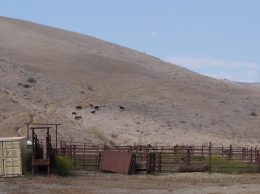Last year it was the Paso Robles groundwater basin. This year it’s Montecito.
Mounting water deficits are forcing smaller communities in the Tri-Counties to take drastic action to cope with the state’s worst drought in decades.
In the case of the Paso Robles groundwater basin, it took a last-minute accord between rival groups, an act of the legislature and new mandates from Gov. Jerry Brown to set in motion the creation of a hybrid special district to manage groundwater supplies into the future.
For Montecito, the options are much more limited. At a meeting of the Montecito Water District on March 24, some 200 residents who attended were presented with two very stark choices — suck it up and pay for water or shell out millions of dollars to build an expensive desalination plant.
In the end residents took the path of least resistance — agreeing to severe rate hikes now and putting off, at least temporarily, the prospect of a desal plant.
Meanwhile a growing group of disgruntled residents is calling for a third and more radical plan—merging the water and sanitary districts and creating a combined plant that would use recycled treated water mixed with desalinated seawater to create a permanent solution.
“There are other alternatives to desalination. It’s time to consider all the possibilities,” said Phil Bernstein, a community member who has been urging the water district to take a look at a combined facility.
Meanwhile, the image of Montecito as a bucolic community where avocado and lemon ranches coexist with opulent mansions from the Gilded Age and the Hedge Fund age is fading away.
At the meeting, Carolyn Chandler, one of just 37 agricultural water users in Montecito said her water rates went up more than residential users and her allocation went down by more as well.
“Our allocation didn’t go down 20 or 30 percent — it went down 60 percent,” she said, adding that the future of her avocado farming operation is now in peril.
“I put a lot of money into cutting down trees, re-doing my irrigation to save water. And I made that 60 percent cut, which was huge,” she said. “I cut down 30 percent of my trees and now the surcharge — applied uniformly — has the potential to cost ag owners up to a 159 percent increase. It’s not a 40 percent increase for us; it’s a 160 percent increase. That hurts. That puts my business out of business.”
Temporarily, purchasing the water is the clear short-term solution, and that’s the only one that water officials are advocating since research into a desalination plant is ongoing.
Water District President Darlene Bierig said supplies will last until “late spring. And then we will come to a grinding halt.”
“There’s this notion that you’re being penalized for conserving. The people who’ve been conserving have been saving us money — all of us money — because we all have to pay for that additional water.”
But the community groundswell for a permanent water resource that’s not dependent on state water or rain is growing in this wealth hamlet of unincorporated Santa Barbara County.
Cindy Feinberg, president of the Montecito Association, said she supports finding an alternative. “I think desalt needs to be explored and we need to have a diversified portfolio of water,” she told the board.
Montecito resident Robert Lewis agreed. “There’s only one solution to the problem here — and it’s a desalination plant,” he said.
On the docket on March 24 was a hefty surchange with a two-fold objective: first, restructure the district finances by temporarily adjusting revenues higher to offset conservation effects, and, second, create funds to offset the district’s financial deficit during the drought emergency.
In the end the surcharge passed. Most experts think the earliest a desalination plant or combined water treatment-desal plant could be operational is 2017.






 Print
Print Email
Email

















